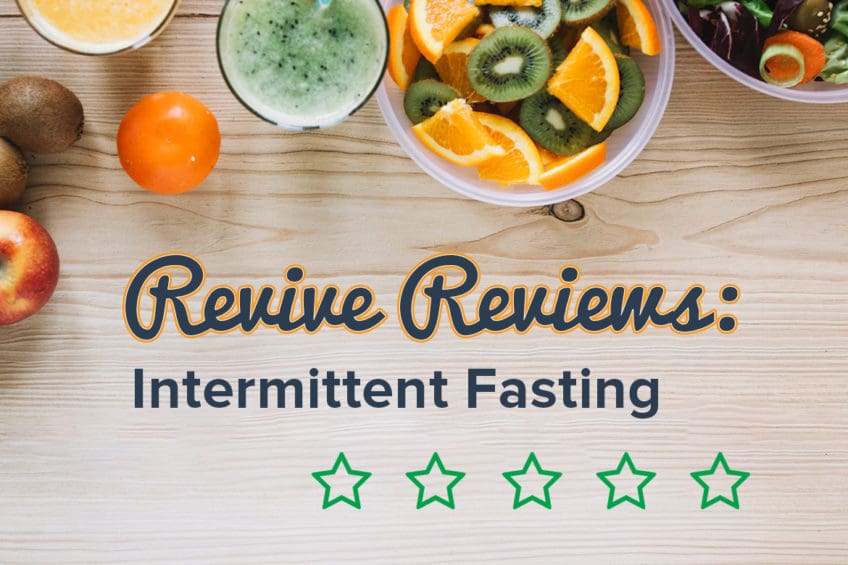Revive Reviews: Intermittent Fasting
Intermittent fasting (IF) means following an eating pattern that cycles through periods of fasting and eating. There are many types of intermittent fasting, including alternate day fasting (ADF), modified fasting, and time-restricted feeding (TRF). IF only sets controls around feeding times, not total energy intake. Research reviews on human findings that compared IF and ADF to a calorie restricted diet found that there were comparable reductions in visceral fat mass, fasting insulin levels, and insulin resistance. Weight loss results with IF are also found to be comparable to a general calorie restricted diet. There are currently no human studies that have published information on long-term health outcomes of IF. There is a need for longer-term human research studies on IF to determine if it can be recommended as a good option to achieve a healthy body weight and other health markers over time.
What are the concerns?
- High hunger levels were a common complaint in the human-based studies. Continually ignoring basic hunger and fullness cues may lead to becoming desensitized to these cues; over time, this can damage one’s relationship with food if eating is no longer intuitive.
- This time-based energy restriction creates a higher risk of binge-eating during a feeding day (or feeding hours). This can lead to feelings of discomfort, guilt, and a damaged relationship with food or eating.
- There are no human studies that go longer than a year, raising concern that IF may not be a sustainable choice. The most effective lifestyle choices are ones that can be maintained over time.
- Intermittent fasting diets have a high dropout rate. This could be due to a negative impact on social relationships and other reported adverse effects such as headaches, dizziness, irritability, and constipation.
With the current evidence available, there is no strong research to support recommending IF for weight loss over a standard calorie reduced diet. Some approaches to intermittent fasting can be done safely: choosing balanced meals and snacks for ideally placed feeding hours during times when one is most active. It is important to understand the reasons or motivation for why you choose intermittent fasting and seek advice of a registered nutritionist. This will help you to ensure you are fueling in a manner that meets your body’s nutritional requirements.
Keep in mind that IF is contraindicated for individuals who are:
- Pregnant/breastfeeding
- Elderly
- Immune compromised
- Nutrient deficient
- Children (<18 years old)
- Athletes with high training volumes
By Susan Sommerville Registered Dietitian & Nutritionist
Ready to Ditch the Diet for Good?
References
-
Moro, T., Tinsley, G., Bianco, A., Marcolin, G., Pacelli, Q. F., Battaglia, G., … Paoli, A. (2016). Effects of eight weeks of time-restricted feeding (16/8) on basal metabolism, maximal strength, body composition, inflammation, and cardiovascular risk factors in resistance-trained males. Journal of Translational Medicine, 14, 290. http://doi.org/10.1186/s12967-016-1044-0
-
Longo, V. D., & Mattson, M. P. (2014). Fasting: Molecular Mechanisms and Clinical Applications. Cell Metabolism, 19(2), 181–192. http://doi.org/10.1016/j.cmet.2013.12.008
-
Barnosky A. R. et al. (2014). Intermittent fasting vs daily calorie restriction for type 2 diabetes prevention: a review of human findings. Translational Research. 164: 4. 302-311. https://doi.org/10.1016/j.trsl.2014.05.013
-
Patterson, R. E., Laughlin, G. A., Sears, D. D., LaCroix, A. Z., Marinac, C., Gallo, L. C., … Villaseñor, A. (2015). INTERMITTENT FASTING AND HUMAN METABOLIC HEALTH. Journal of the Academy of Nutrition and Dietetics, 115(8), 1203–1212. http://doi.org/10.1016/j.jand.2015.02.018
-
Collier, R. (2013). Intermittent fasting: the science of going without. CMAJ : Canadian Medical Association Journal, 185(9), E363–E364. http://doi.org/10.1503/cmaj.109-4451
-
Hankey C., Klukowska D., Lean M. (2015). A systematic Review of the Literature on Intermittent Fasting for Weight Management. The Federation of American Societies for Experimental Biology. Accessed from: http://www.fasebj.org/doi/abs/10.1096/fasebj.29.1_supplement.117.4

